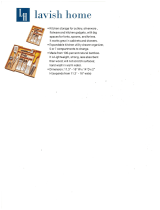
Instructions for the User
41
11.6 Operating noise
The refrigerator and freezer are cooled by means of a compression system. In order to maintain the
preset temperature inside the refrigerator and freezer sections, the compressor comes into operation in
response to the level of cooling required, and may operate continuously if necessary. When the
compressor starts up a humming sound will be heard, tending to drop in volume after a few minutes.
Other normal refrigerator operating noises are a gurgling and a rustling due to the refrigerant flowing
through the pipes in the circuit. These noises are perfectly normal and do not mean that the appliance is
malfunctioning. If they are over-loud, there may be other causes. In this case, check that:
- the refrigerator is properly levelled on the floor and does not vibrate when the compressor is in
operation: adjust the feet provided as appropriate;
- the drawers, shelves and door boxes are correctly fitted and securely in place: fit correctly;
- bottles and containers on the various shelves are stable and not touching: the vibration due to
operation of the compressor may generate some noise;
- do not place kitchen units or other appliances so that they are touching the refrigerator.
11.7 Identifying and dealing with possible malfunctions
Your new refrigerator has been designed and built to strict quality standards. This section is intended to
enable you to identify the origin of any malfunctions which may occur before contacting your local
authorised After-Sales Service.
PROBLEM POSSIBLE CAUSE PROBABLE SOLUTION
Noisy operation - see “11.6 Operating noise”
The compressor starts up too often or
operates continuously:
- compressor and condenser
cooling inadequate:
- rise in outside temperature;
- doors opened often or for long
periods;
- too much fresh food placed in the
appliance:
- check that the rear of the
appliance is properly ventilated as
explained in point “4. installation
and connection” and that the
condenser is not over-dirty;
- freeze less food at a time;
The compressor does not start up: - switches off;
- power supply lead not connected
to the electrical mains;
- mains socket not supplying
electrical power;
- room temperature too high.
- Press buttons ;
- connect the cable to the power
supply;
- contact the electricity supplier
Refrigerator section not cooled
sufficiently:
- Inside temperature set too high
(meaning reduced cooling effect).
- door opened often or for long
periods.
- Adjust the temperature using the
or keys as described in
points 6.1.3 Temperature regulator
buttons;
- open the door less often and for
as short a time as possible
Temperature inside freezer section
not low enough to freeze foods
properly:
- inside temperature setting
thermostat set on too high a
temperature;
- door opened often or for long
periods;
- door not closing with an airtight
seal;
- too much sugar in foods for
freezing
- Lower the temperature using the
key as described in points
7.1.2 Temperature regulator
buttons ;
- open the door less often and for
as short a time as possible;
- check that the foods are arranged
on the shelves correctly, that the
gasket is sealing properly and is
not damaged, and that the
refrigerator is well levelled on the
floor
- some foods can only be
completely frozen at very low
temperatures (ice-cream,
concentrated fruit-juices)





















